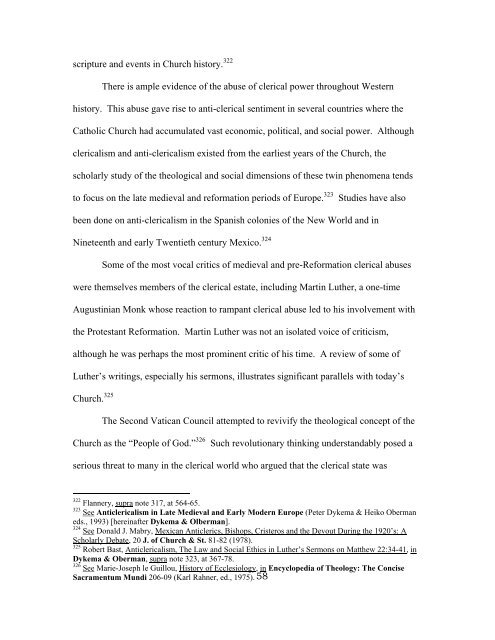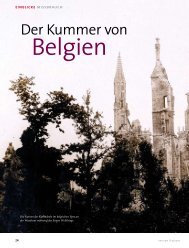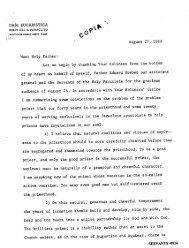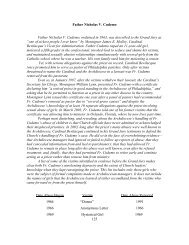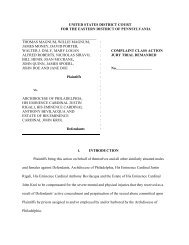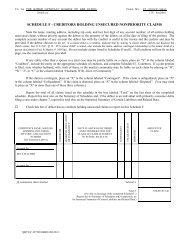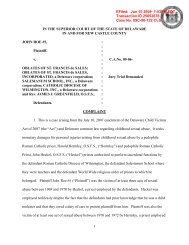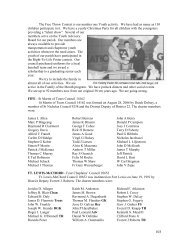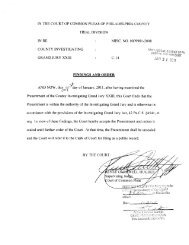1 1 Catholic Clergy Sexual Abuse Meets the Civil Law by Thomas P ...
1 1 Catholic Clergy Sexual Abuse Meets the Civil Law by Thomas P ...
1 1 Catholic Clergy Sexual Abuse Meets the Civil Law by Thomas P ...
Create successful ePaper yourself
Turn your PDF publications into a flip-book with our unique Google optimized e-Paper software.
scripture and events in Church history. 322<br />
There is ample evidence of <strong>the</strong> abuse of clerical power throughout Western<br />
history. This abuse gave rise to anti-clerical sentiment in several countries where <strong>the</strong><br />
<strong>Catholic</strong> Church had accumulated vast economic, political, and social power. Although<br />
clericalism and anti-clericalism existed from <strong>the</strong> earliest years of <strong>the</strong> Church, <strong>the</strong><br />
scholarly study of <strong>the</strong> <strong>the</strong>ological and social dimensions of <strong>the</strong>se twin phenomena tends<br />
to focus on <strong>the</strong> late medieval and reformation periods of Europe. 323 Studies have also<br />
been done on anti-clericalism in <strong>the</strong> Spanish colonies of <strong>the</strong> New World and in<br />
Nineteenth and early Twentieth century Mexico. 324<br />
Some of <strong>the</strong> most vocal critics of medieval and pre-Reformation clerical abuses<br />
were <strong>the</strong>mselves members of <strong>the</strong> clerical estate, including Martin Lu<strong>the</strong>r, a one-time<br />
Augustinian Monk whose reaction to rampant clerical abuse led to his involvement with<br />
<strong>the</strong> Protestant Reformation. Martin Lu<strong>the</strong>r was not an isolated voice of criticism,<br />
although he was perhaps <strong>the</strong> most prominent critic of his time. A review of some of<br />
Lu<strong>the</strong>r’s writings, especially his sermons, illustrates significant parallels with today’s<br />
Church. 325<br />
The Second Vatican Council attempted to revivify <strong>the</strong> <strong>the</strong>ological concept of <strong>the</strong><br />
Church as <strong>the</strong> “People of God.” 326 Such revolutionary thinking understandably posed a<br />
serious threat to many in <strong>the</strong> clerical world who argued that <strong>the</strong> clerical state was<br />
322<br />
Flannery, supra note 317, at 564-65.<br />
323<br />
See Anticlericalism in Late Medieval and Early Modern Europe (Peter Dykema & Heiko Oberman<br />
eds., 1993) [hereinafter Dykema & Olberman].<br />
324<br />
See Donald J. Mabry, Mexican Anticlerics, Bishops, Cristeros and <strong>the</strong> Devout During <strong>the</strong> 1920’s: A<br />
Scholarly Debate, 20 J. of Church & St. 81-82 (1978).<br />
325<br />
Robert Bast, Anticlericalism, The <strong>Law</strong> and Social Ethics in Lu<strong>the</strong>r’s Sermons on Mat<strong>the</strong>w 22:34-41, in<br />
Dykema & Oberman, supra note 323, at 367-78.<br />
326<br />
See Marie-Joseph le Guillou, History of Ecclesiology, in Encyclopedia of Theology: The Concise<br />
Sacramentum Mundi 206-09 (Karl Rahner, ed., 1975).<br />
58


